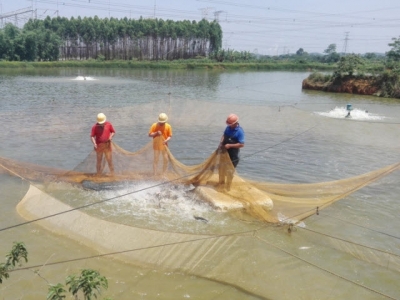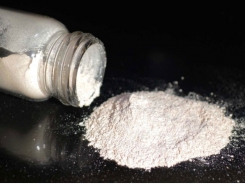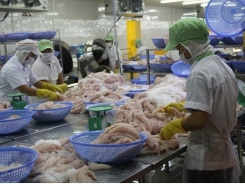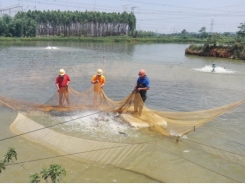Bio-economic modeling for improving aquaculture performance (Part 2)

5/ Harvesting small-size tilapia
Some experts suggested that farming small-size tilapia could be more profitable (see, for example, the article “Could aquaculture solve Africa’s fishing crisis?” published by The Guardian on 5 June 2013). We used the bio-economic model to examine this conjecture. The simulation results indicate that given the low price for small-size tilapia (< 500 grams) in the Chinese market, harvesting small-size tilapia would not be more profitable. However, if without the price discrepancy, harvesting small-size tilapia (average 250 to 300 grams) in two-year, five-crop arrangements would tend to be more productive and profitable than one-year, two-crop arrangements that harvest > 500-gram fish (Fig. 2).

Fig. 2: Profitability and productivity – two years, five crops versus one year, two crops. Source: Cai et al. (2018, p.49).
The simulation results indicate that none of the smaller harvest size, more crops or higher productivity is a sufficient condition for higher profitability. Thus, it is important to understand why harvesting small-size fish could increase the profitability. Farming relatively small-size fish can have a positive impact on profitability by allowing a higher stocking density (hence utilizing the pond area more efficiently). As mentioned above, the bio-economic model sets a carrying capacity threshold for total fish biomass in the pond, which would limit the stocking density according to the targeted harvest size.
Thus, a lower harvest size would allow a higher stocking density, which would increase the efficiency in pond utilization by increasing the fish biomass in the pond at the early stage when fish are small and lowering the FCR. However, farming small-size fish tends to be inefficient in the use of fingerlings and may miss the fast-growing part of tilapia growth. For example, in the baseline tilapia growth pattern used to calibrate the bio-economic model, it takes 14 weeks for the fish to grow from 1 gram to 250 grams, whereas it takes only an additional four weeks to grow over 500 grams. Harvesting small-size tilapia would improve profitability only when the positive impact outweighs the negative impact.

Harvested tilapia. Photo by Junning Cai.
6/ Multi-tier farming system
As discussed above, targeting smaller harvest size can increase the efficiency of pond utilization yet may miss the fasting growing part of tilapia growth. A multi-tier farming system could help farmer enjoy the benefit of the former without the cost of the latter. In a nutshell, a multi-tier farming system is to adjust the stocking density according to fish size so as to maintain the fish biomass in the pond at high levels. Such multi-tier systems have become increasingly popular. Tilapia farmers in Hainan province (China) often use a two-tier farming system to separate the nursing stage and outgrowing stage; some farmers even add an additional tier for growing fry to fingerlings – see more technical details in Cai et al. (2018, p. 53).
The bio-economic model has been used to simulate the farming arrangements of separating the nursing stage (growing 1-gram fingerlings to large-size fingerlings: 50 g, 100 g or 150 g) and the out-growing stage, and evaluate the technical and economic performance of the two-tier system. The results indicate that with the possibility of using large-size fingerlings farmed more efficiently under higher stocking density, the two-tier system could allow one-year, three-crop arrangements that increase the profitability by 60 to 90 percent (depending on initial stocking timings) compared to standard one-year, two-crop arrangements that use only 1-gram fingerlings.
7/ Cai, bio-economic modeling,
| Indicators | First crop | Second crop | Third crop | Average |
| Stocking date | 30 April | 15 October | 22 January | - |
| Harvest date | 1 October | 8 January | 16 April | - |
| Fingerling size (g) | 1 | 100 | 150 | 82.6 |
| Stocking density (fish/mu) | 2,100 | 2,100 | 2,000 | 2,067 |
| Growing period (weeks) | 22 | 12 | 12 | 15.3 |
| Harvest size (g) | 504 | 506 | 523 | 511 |
| Productivity (kg/ha/week) | 662 | 1,137 | 1,121 | 914 |
| Productivity (kg/ha/year) | - | - | - | 47,507 |
| Profitability (CNY/ha/week) | 1,645 | 4,535 | 3,628 | 2,958 |
| Profitability (CNY/ha/year) | - | - | - | 153,082 |
Table 1: Arrangements that maximize profitability under one year, three crops. Source: Cai et al. (2018, Table 14).
The results also indicate that there is no single, most suitable fingerling size; most of the optimal one-year, three-crop arrangements for the 52 (weekly) initial stocking timings entail the use of different fingerling sizes for different crops – see an example in Table 1 which presents the one-year, three-crop arrangement that would generate the highest overall profit.

Live tilapia sold in a supermarket. Photo by Junning Cai.
8/ Way forward
Our bio-economic modeling endeavor started from the attempt to develop a simple model for identifying optimal harvesting strategies and ended with a bio-economic model that captures the impact of seasonal water temperature variation on fish growth and allows farmers to optimizing farming arrangement by selecting four technical parameters (stocking timing, fingerling size, stocking density and growing period). But this is only a baby step towards the ultimate goal of using bio-economic modeling to facilitate fish farmers’ business and operation planning in practice.
Being a sophisticated model notwithstanding, the bio-economic model has much room to improve. The biological part of the model can be strengthened by more rigorous modeling of fish growth based on more detailed, comprehensive data on tilapia growth under different conditions (water temperature, stocking density, feeding regimes, etc.) and accounting for more environmental factors (water supply, climate changes, etc.), while the economic part can be enhanced by accounting for the seasonality of the availability and prices of seed, feed and other inputs as well as fish price and introducing uncertainties to facilitate risk analysis.
Last but perhaps most importantly, a bio-economic model needs to be tailor-made according to local farming conditions and practices in order to become a practical tool for optimizing farming arrangements. Achieving this ultimate goal entails long-term, collective efforts of farmers, researchers, extension personnel and policymakers. Yet the benefit would certainly be worthwhile.
Related news
Tools

Phối trộn thức ăn chăn nuôi

Pha dung dịch thủy canh

Định mức cho tôm ăn

Phối trộn phân bón NPK

Xác định tỷ lệ tôm sống

Chuyển đổi đơn vị phân bón

Xác định công suất sục khí

Chuyển đổi đơn vị tôm

Tính diện tích nhà kính

Tính thể tích ao




 S Korea to inspect VN shrimp firms
S Korea to inspect VN shrimp firms  Bio-economic modeling for improving aquaculture performance (Part 1)
Bio-economic modeling for improving aquaculture performance (Part 1)